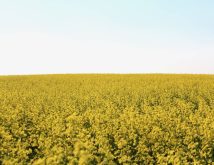SOUTHWEST
Most areas received rainfall over the past week with totals varying from 25 to 45 millimetres. Some areas received heavy thundershowers and areas in the northern part of the region reported temperatures close to 0C.
Most early-seeded cereal crops are heading, with later-seeded crops in the flag leaf to early-head stage. Most canola crops are flowering, with reseeded canola bolting. Flax is flowering in most areas. Sunflowers are prebud (R1) stage and corn is still vegetative. Winter cereals are starting to turn.
The hay crop is coming off and most areas report below-average yields. Pastures are holding on since the last rainfall, but more rain is required if hot weather is received over the next few days.
Read Also

Manitoba boosts stake in cereals centre to $23.5 million
Premier Wab Kinew said the additional project funds will help ‘Trump-proof’ the provincial economy.
There are reports of grasshoppers in some areas. Producers have been spraying for aphids in peas, and barley thrips.
NORTHWEST
Heavy thunderstorms Sunday brought variable rain to the east of the region, with 25 mm falling around Ste. Rose. More rain is needed in the Roblin and Swan River areas.
Cereal crops are 50-95 per cent headed out, peas are 50-85 per cent flowering and 10-45 per cent of canola fields are beginning to pod. Grasshoppers are evident on lighter soils. Wheat midge is present in a few fields, which will likely affect grade more than yield. Fungicide applications on canola are near completion.
Haying ranges from 25 to 50 per cent complete, with more done in the Swan River area. Yields are average to below average, ranging from one to 1.75 dry matter tonnes per acre, with good quality thus far. Some major alfalfa weevil damage is still being reported, particularly in the region’s east. Pasture conditions are rated fair to good.
CENTRAL
The area this past week had rainfall ranging from zero to 15 mm on July 15, with Somerset and Portage getting the higher amounts. Thundershowers went through July 20, bringing zero to 20 mm and up to 50 mm in the Morris area.
Canola is being sprayed for sclerotinia, except for a few poor stands due to frost, flea beetles, water ponding and excess moisture. Cereals are being sprayed for leaf and head disease protection. Staging on canola and cereals has been difficult because of variable staging in some fields.
Grasshoppers are being sprayed where necessary. Bertha army worm numbers are up marginally this past week and are still considered low for this time of year.
Potato growth is variable, with the most advanced fields filling in between rows. At Carberry and Treherne, early-seeded potato fields have been sprayed with fungicides two or three times. Laterseeded areas are just starting to spray for disease.
The first-cut hay crop is almost complete with good yields; quality varies depending on rain. Secondcut alfalfa is growing well.
EAST
Rainfall early in the week continues to stress crops. Crop stages vary, with cereals ranging from boot stage to heading. Most barley fields have headed this past week; spring wheat fields are about 50 per cent headed. Earlyseeded canola is past the 50 per cent bloom stage, but over half the acres are either in the early-flowering stage or just starting to bolt. Fungicide applications on the most advanced canola are complete.
Soybeans were mostly in the R1 leaf stage but are extremely short. Iron deficiency chlorosis in soybeans is now in its second week. Flax is 20-30 cm tall and starting to bud. Corn development varies, with crop heights ranging from 0.4 to 1.5 metres.
Hayfields and pastures were rated as good. First-cut hay is wrapping up for the season and second-cut alfalfa is about a week behind normal. Alfalfa yields are below average at 1.5 tonnes per acre and alfalfa/grass stands producing two tonnes per acre.
Concerns that the corn, soybeans and sunflowers will require an exceptionally long growing season to reach maturity are worrisome to many growers.
INTERLAKE
Rainfall accumulations this past week ranged between 17 and 45 mm. An area south of Stonewall reported up to 75 mm of rain, with soils becoming saturated and water ponding in fields. Moisture conditions in the northwest of the region are adequate for now.
In the north, cereals are in the four-to five-leaf stage, and canola is just bolting to early bloom. In the south, fungicide applications on cereals and canola continue.
Flax fields continue to flower, with earlier-seeded fields estimated to have 70 to 80 per cent boll set and 20 to 30 per cent flowering.
Soybean crops are starting to flower. Corn varies in height and is about 20 to 24 inches tall and up to the fourth-collar stage.
Advanced winter wheat crops are turning a lighter colour and seed development is around the milky-dough stage.
Progress was made on perennial forage harvest over the week. Most fields that have been harvested have many low spots left out, as there is water remaining.














